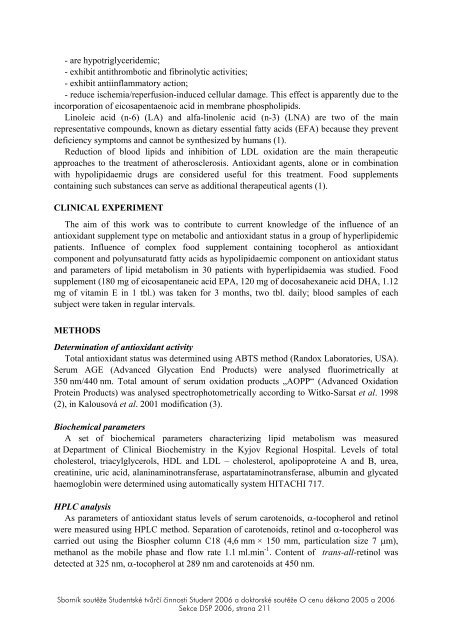production of selected secondary metabolites in transformed ...
production of selected secondary metabolites in transformed ...
production of selected secondary metabolites in transformed ...
You also want an ePaper? Increase the reach of your titles
YUMPU automatically turns print PDFs into web optimized ePapers that Google loves.
- are hypotriglyceridemic;<br />
- exhibit antithrombotic and fibr<strong>in</strong>olytic activities;<br />
- exhibit anti<strong>in</strong>flammatory action;<br />
- reduce ischemia/reperfusion-<strong>in</strong>duced cellular damage. This effect is apparently due to the<br />
<strong>in</strong>corporation <strong>of</strong> eicosapentaenoic acid <strong>in</strong> membrane phospholipids.<br />
L<strong>in</strong>oleic acid (n-6) (LA) and alfa-l<strong>in</strong>olenic acid (n-3) (LNA) are two <strong>of</strong> the ma<strong>in</strong><br />
representative compounds, known as dietary essential fatty acids (EFA) because they prevent<br />
deficiency symptoms and cannot be synthesized by humans (1).<br />
Reduction <strong>of</strong> blood lipids and <strong>in</strong>hibition <strong>of</strong> LDL oxidation are the ma<strong>in</strong> therapeutic<br />
approaches to the treatment <strong>of</strong> atherosclerosis. Antioxidant agents, alone or <strong>in</strong> comb<strong>in</strong>ation<br />
with hypolipidaemic drugs are considered useful for this treatment. Food supplements<br />
conta<strong>in</strong><strong>in</strong>g such substances can serve as additional therapeutical agents (1).<br />
CLINICAL EXPERIMENT<br />
The aim <strong>of</strong> this work was to contribute to current knowledge <strong>of</strong> the <strong>in</strong>fluence <strong>of</strong> an<br />
antioxidant supplement type on metabolic and antioxidant status <strong>in</strong> a group <strong>of</strong> hyperlipidemic<br />
patients. Influence <strong>of</strong> complex food supplement conta<strong>in</strong><strong>in</strong>g tocopherol as antioxidant<br />
component and polyunsaturatd fatty acids as hypolipidaemic component on antioxidant status<br />
and parameters <strong>of</strong> lipid metabolism <strong>in</strong> 30 patients with hyperlipidaemia was studied. Food<br />
supplement (180 mg <strong>of</strong> eicosapentaneic acid EPA, 120 mg <strong>of</strong> docosahexaneic acid DHA, 1.12<br />
mg <strong>of</strong> vitam<strong>in</strong> E <strong>in</strong> 1 tbl.) was taken for 3 months, two tbl. daily; blood samples <strong>of</strong> each<br />
subject were taken <strong>in</strong> regular <strong>in</strong>tervals.<br />
METHODS<br />
Determ<strong>in</strong>ation <strong>of</strong> antioxidant activity<br />
Total antioxidant status was determ<strong>in</strong>ed us<strong>in</strong>g ABTS method (Randox Laboratories, USA).<br />
Serum AGE (Advanced Glycation End Products) were analysed fluorimetrically at<br />
350 nm/440 nm. Total amount <strong>of</strong> serum oxidation products „AOPP“ (Advanced Oxidation<br />
Prote<strong>in</strong> Products) was analysed spectrophotometrically accord<strong>in</strong>g to Witko-Sarsat et al. 1998<br />
(2), <strong>in</strong> Kalousová et al. 2001 modification (3).<br />
Biochemical parameters<br />
A set <strong>of</strong> biochemical parameters characteriz<strong>in</strong>g lipid metabolism was measured<br />
at Department <strong>of</strong> Cl<strong>in</strong>ical Biochemistry <strong>in</strong> the Kyjov Regional Hospital. Levels <strong>of</strong> total<br />
cholesterol, triacylglycerols, HDL and LDL – cholesterol, apolipoprote<strong>in</strong>e A and B, urea,<br />
creat<strong>in</strong><strong>in</strong>e, uric acid, alan<strong>in</strong>am<strong>in</strong>otransferase, aspartatam<strong>in</strong>otransferase, album<strong>in</strong> and glycated<br />
haemoglob<strong>in</strong> were determ<strong>in</strong>ed us<strong>in</strong>g automatically system HITACHI 717.<br />
HPLC analysis<br />
As parameters <strong>of</strong> antioxidant status levels <strong>of</strong> serum carotenoids, α-tocopherol and ret<strong>in</strong>ol<br />
were measured us<strong>in</strong>g HPLC method. Separation <strong>of</strong> carotenoids, ret<strong>in</strong>ol and α-tocopherol was<br />
carried out us<strong>in</strong>g the Biospher column C18 (4,6 mm × 150 mm, particulation size 7 μm),<br />
methanol as the mobile phase and flow rate 1.1 ml.m<strong>in</strong> -1 . Content <strong>of</strong> trans-all-ret<strong>in</strong>ol was<br />
detected at 325 nm, α-tocopherol at 289 nm and carotenoids at 450 nm.<br />
Sborník soutěže Studentské tvůrčí č<strong>in</strong>nosti Student 2006 a doktorské soutěže O cenu děkana 2005 a 2006<br />
Sekce DSP 2006, strana 211
















